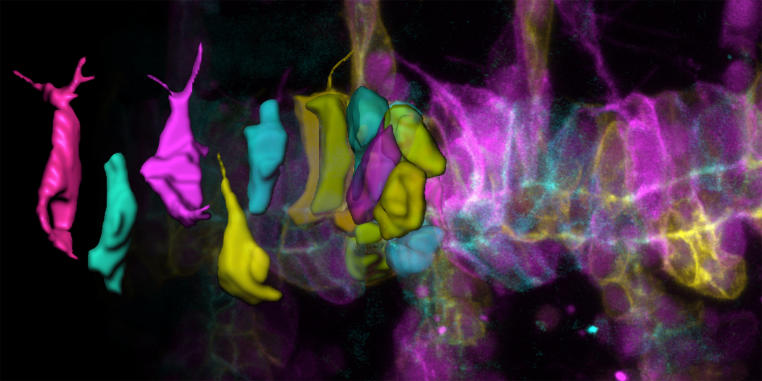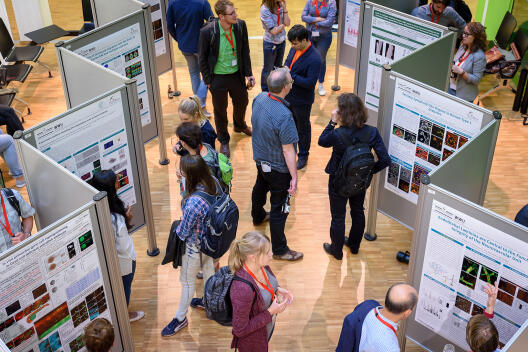Conference Report
International CiM Symposium | Cells in Motion: Pattern formation in space and time | Münster, 4–6 September 2017
In a true testament to interdisciplinary research, the 2017 International CiM Symposium was recently held at the WWU Münster and brought together experts from the fields of biomedicine, biology, chemistry, biophysics, mathematics and computer science. The organising committee (T. Betz, R. Gilmour, G. Lenz, S. Luschnig, A. Rentmeister, S. Schulze-Merker, R. Wedlich-Söldner, B. Wirth - all WWU Münster) decided on the alluring conference theme “Patterns in space and time” and left the interpretation entirely up to a veritable who’s who of leading experts. The challenge for each speaker was to effectively convey sophisticated, cutting edge science to a mixed audience of clinicians and natural scientists. The end result was a 3-day tour-de-force in manipulating, studying and understanding cell behaviour.
Following a general introduction to the Cluster of Excellence “Cells in Motion” by Lydia Sorokin (WWU Münster), the opening session (Chair: Volker Gerker, WWU Münster) on membrane organisation began with a thoughtful discussion of membrane-localised interactions and transport diffusion processes in cells by Mathias Röger (TU Dortmund). From mathematics, the programme then switched to biophysics and a lecture by Milos Galic (WWU Münster) on nanoscale membrane deformations and their effects on lamellipodia re-initiation, cell shape and migration pattern. The session concluded with a lecture from Patricia Bassereau (Institut Cuire, Paris) on I-BAR proteins and Ezrin in the context of curved membranes.
Session two entitled “Visualising cells and manipulating processes in living cells” (Chair: Andrea Rentmeister, WWU Münster) focussed on the important role of chemistry. The importance of bio-orthogonal reactions in visualising drug metabolism and embryogenesis was emphasised by Nathan Leudtke (University of Zürich). In a switch to glycochemistry, Benjamin Schumann from Stanford University spoke about glycosyltransferase bump-hole engineering to dissect mucin-type O-glycosylation in living cells. The session was rounded off by Markus Affolter (University of Basel) who delivered a lecture entitled “Angiogenesis live: new insights and new tools”.
Session three, chaired by Milos Galic and Sebastian Rumpf, provided a platform for young investigators funded through the CiM Cluster to share their latest results. Speakers included Johannes Fels, Robert Meissner, Maniraij Bhagawati, Kathleen Hübner and Sargon Yigit (all WWU Münster).
The evening lecture, chaired by Erez Raz (WWU Münster), was delivered by Benny Shilo from the Weizmann Institute of Science. Entitled “Life’s Blueprint”, this talk was a beautiful balance between scientific complexity and everyday occurrences. Peppered with photographs and images from Shilo’s own collection, the lecture was both accessible and expressive. The first day of the meeting concluded with a reception and poster presentations.
The first session on Tuesday 5th September (Session 4. Chair: Ryan Gilmour, WWU Münster) kicked off with Arndt Siekmann’s (WWU Münster) lecture entitled “Endothelial notch signalling limits angiogenesis via controlled artery formation”. This was followed by a change in pace to mathematics and a presentation on modelling biological transport mechanisms by Peter Markowich from the University of Cambridge. The session concluded with the sole industrial speaker, Nick Meanwell (Bristol-Myers Squibb) who gave an account of BMS’s development of modulators of hepatitis C virus NS5A.
Session 5 focussed on the theme of mechanobiology (Chair: Timo Betz, WWU Münster), beginning with the subject of tissue viscoplasticity in a lecture by Michel Labouesse (Institut de Biologie Paris-Seine). Maja Matis (WWU Münster) addressed the control of tissue mechanics, before handing the floor to Matthieu Piel (Institut Curie, Paris) for lecture intriguingly entitled “Squeezing the nucleus”.
Central to the CiM initiative is cellular communication, the subject of session 6 chaired by Stefan Lusching. Commencing with a lecture by Stefan Sigrist (FU Berlin) on pre-post-synaptic communication patterns, the session then moved to chemical ecology and explored cellular communications in a two-kingdom symbiosis (Jon Clardy, Harvard University). Regeneration was the subject of the next lecture by Kerstin Bartscherer (MPI for Molecular Biomedicine), specifically understanding the mechanism of this process in flatworms. The final talk of this session moved to mathematics, and was given by Jan-Frederik Pietschmann (WWU Münster) on the development of a phase separation model with non-local interactions.
Following a short break, the second day concluded with session 6 entitled “Frontiers in imaging” chaired by Michael Schäfers (WWU Münster). David O’Hagan (St Andrews) demonstrated how an enzyme can be harnessed to form 18F-C bonds for application in positron emission tomography. Wolfram Pernice (WWU Münster) shared his lab’s latest results in the field of photonic nanostructures for imaging, and the session concluded with a lecture from Erik Sahai (The Francis Crick Institute, London) on cancer cell invasion in complex environments. The programme concluded with a Speakers Dinner held in the Picasso Museum, Münster (Restaurant La Californie) and a convivial evening was had by all.
The final day (Session 8, Chair: Roland Wedlich-Söldner, WWU Münster) was opened by Zena Werb from the University of California, San Francisco who discussed cancer progression and the importance of intravital imaging in revealing cell-matrix interactions. Peter Seeberger (MPI Potsdam) then discussed the importance of chemical glycobiology as a platform for vaccine development, and demonstrated how automated glycan assembly can facilitate this process. The penultimate lecture of the session was delivered by Britta Trappmann from the bioactive materials lab at the MPI in Münster entitled “Regulation of cell fate by extracellular matrix stiffness”. The finale to session 8 was provided by Martin Schwartz (Yale Cardiovascular Research Group) who lectured on the response of cells to forces applied through integrins.
Session 9 was devoted to tissue morphogenesis and chaired by Stefan Schulte-Merker (WWU Münster). The temporal basis of angiogenesis was addressed by Katie Bentley (Uppsala University) before a switch in themes to spatiotemporal control of dendrite pruning in Drosophila by Sebastian Rumpf (WWU Münster).
The 2017 International CiM Symposium was a huge success thanks to the 31 national and international speakers who were so very generous in sharing both their time and expertise. On behalf of the organising committee, we would like to express our deepest gratitude. Of course, a meeting of this complexity would not have been possible without the organisational support of our very dedicated CiM Office team, and in particular Ann-Christin Dietrich and Christel Marx.
The symposium was an excellent way to celebrate the Cluster’s success in Münster, but perhaps more importantly it provided inspiration and motivation for the future. We look forward to welcoming you to the next meeting in 2019!
Christiane Natsch and Ryan Gilmour










